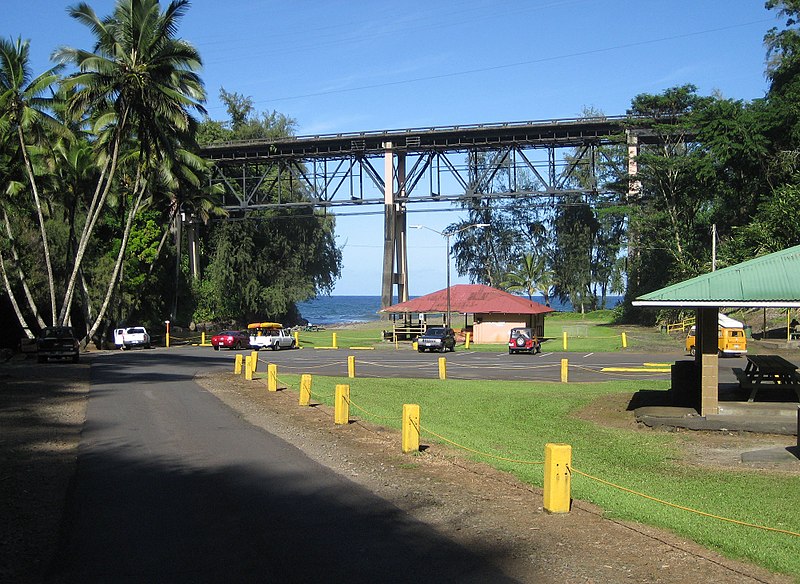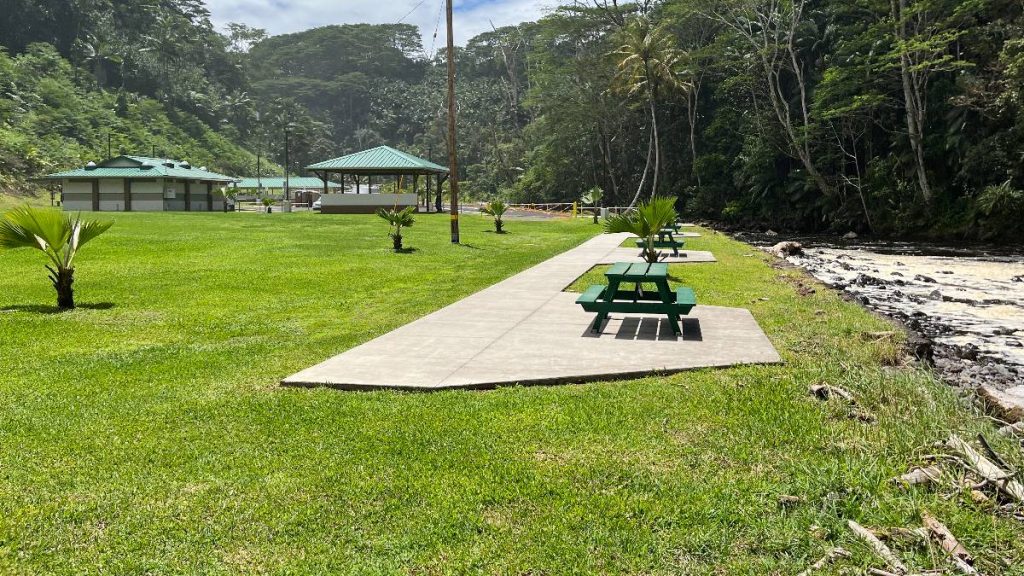Lead contamination at Kolekole Gulch Park still an issue as Hawai‘i County readies to reopen it following accessibility upgrades
Kolekole Gulch Park in Kūhua, just north of Honomū on the Big Island’s Hāmākua Coast, is a valuable resource.
Hawai‘i County Mayor Mitch Roth has described is “an important point of access … for fishing, swimming, surfing and overall enjoyment of the [nearby] stream and ocean, activities that are vital to our culture and the well-being of local residents.”
His administration is excited to reopen Kolekole next week following the completion of a $6.3 million project to upgrade aging infrastructure and bring the park into compliance with the Americans with Disabilities Act, making it more accessible for everyone.

However, there’s a soft, dense, blue-gray issue that continues to be a metal thorn in the park’s side — lead contamination of its soil.
Remediation of the problem, a responsibility of the Hawai‘i Department of Transportation because it oversees the Kolekole Stream Bridge passing overhead, has yet to be completed more than 7 years after the first contaminated soil was found.
The contamination’s origin was likely lead-based paint used on the bridge from 1950 through 2000. Small lead paint flakes could have fallen from the bridge as it aged and was impacted by weather, as well as during past maintenance work.
The paint flakes would have been dispersed into the park’s soil below, causing the contamination.
All of the remaining lead paint was removed in 2001 from the bridge, eliminating the possibility of any additional flakes falling in the future.
The park was first closed in April 2017 because of the contamination.
Initial soil sampling showed lead present in the area under and west of the bridge, exceeding the 200 mg/kg screening action level in Hawai‘i. Additional assessments from 2017 to 2019 identified contaminated soil above screening levels in much of the park’s open grassy areas.
County lawn maintenance workers also wore badges that collected dust as they went about their regular duties at the park as part of an exposure assessment, which fortunately found they were not exposed to lead dust. The impacted soil is also covered by thick grass, helping minimize contact and reducing concern about health risks.
Lead-contaminated soil is a potential health risk, especially to young keiki who play at the park and could accidentally eat small amounts of the soil or even paint flakes themselves. The metal is more harmful to children than adults as it is particularly toxic to their developing brains and neurologic systems and can accumulate and persist in their bodies.
Infants and young keiki are particularly sensitive to even low levels of lead, which can contribute to behavioral problems, learning deficits and lowered IQ.

Adults also can experience adverse effects from lead, mostly cardiovascular issues such as high blood pressure, heart disease and others, depending on the level of exposure.
The park remained closed until March 2020, after the county — in collaboration with the state Transportation Department and Hawai‘i Department of Health — established several measures for its safe reopening.
The park was closed again in late 2021 because of an emergency repair project on the overhead bridge. The project was finished in July 2022, but the park was closed again in September of that year for the county’s upgrades and has remained shuttered since.
A Transportation Department spokesperson reported in June 2022 to one Big Island media outlet that lead remediation work was expected to begin by spring of this year, along with permanent repairs to the bridge, but that has not been the case.
Big Island Now reached out to Harry Takiue, district engineer for the Hawai‘i District of the state Transportation Department’s Highways Division, for information about the remediation timeline and what the holdup has been on the project; however, he referred questions to the department’s public affairs office, which did not respond to the inquiries before publication.
The only clean up so far happened during the county’s accessibility project, when contaminated soil was removed from around the park’s pre-existing buildings and in areas where construction of foundations for new buildings, structures, walkways, utility lines, landscaping and other upgrades was done.
“The balance of the lead-contaminated soil is makai [oceanside] of the new comfort station and pavilion, currently encapsulated by vigorous lawn — which is why we’re not allowing camping uses,” said Hawai‘i County Department of Parks and Recreation Director Maurice Messina. “The area of highest levels of lead in the soil continue to be fenced off by a chain-link enclosure that was installed and is maintained by state [Department of Transportation Highways].”
Because lead contamination still exists, the interim safety measures put in place in 2020 will go back into effect when the park reopens April 24.
Those measures are:
- Maintenance of healthy grass cover to reduce the potential for exposure.
- Installation and maintenance of fencing around the area with the highest lead levels in surface soil to prevent public access.
- Posted signs to notify and caution the public regarding potential lead exposure in soils below grass in the park.
- Restriction of specific activities by county staff and the public that would risk exposing bare soils, including camping, open fires, charcoal barbeques, vehicles driving on the grass, pounding of stakes into grass and any digging activities.
Roth’s administration prioritized completing the accessibility upgrades at Kolekole because it’s a critical resource for the people of the Hāmākua coastline, said the mayor’s executive assistant Cyrus Johnasen.
“There are only so many locations to access the ocean from Hilo to Honoka‘a, and we know that puts a strain on connection for many of our local families,” said Johnasen. “Studies were done to assess lead contamination levels, to which we found it acceptable to move forward with our work.”
No laborers who worked on any aspect of the county project have made claims of health issues related to their work, nor have any of the county’s Parks and Recreation workers. He reiterated that the county has done its best to block off access to areas where contamination is known and continues to upkeep the grounds to ensure adequate soil retention.
Signage at the park also was updated to reflect the ongoing issue.
“The state continues to be a great partner and has updated us regularly on [its] project status,” Johnasen said. “That said, for a myriad of reasons, particularly related to the sugar cane industry, contamination affects the majority of our popular coastlines and communities. For example, levels of arsenic are known in Hilo Bay and Wailoa River from the old cane factory found along its embankment. Yet, families are still able to swim and enjoy.”
He said the administration must weigh the “what ifs” with the “what is” and make decisions accordingly. The risk of disconnecting people from natural and cultural resources is more of a risk than possible health issues related to identified remnants of lead contamination.
“So long as we do our best to inform the community of what potential risks may exist and do what we can to mitigate those we know do exist, we believe we will continue to have safe access to our oceans, mountains and streams,” Johnasen said.
The Department of Parks and Recreation is hosting a public reopening event at 10 a.m. April 24 at the 5.5-acre park located in a steep gulch between Old Māmalahoa Highway and Kolekole Stream, just mauka (mountainside) of the bridge.
Messina said in a recent press release that the parks looks and feels entirely new after the upgrades.
The park project is one of several county construction projects underway or recently completed that enhance accessibility and ensure the island’s parks meet requirements of the Americans with Disabilities Act.
“By enhancing accessibility for all and introducing upgraded amenities, we are securing its place as a cherished community space for generations to come,” Roth recently said in a press release about the completion of the project.

Kolekole is not the only Big Island park shuttered because of lead contamination caused by a state bridge. Hakalau Beach Park, just less than 2 miles north, was also closed in 2017 because of contamination from the overhead Hakalau Stream Bridge.
The state has not done any remediation work there either. The park remains closed.
















